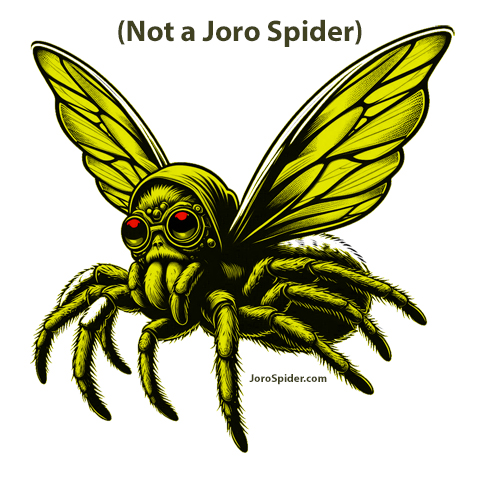What is Ballooning or “Do Spiders Really Fly?”
Looking for a Forever Home and a Whole Lotta Love
Let’s cut to the chase. No, Joro spiders don’t fly. If you bet your Uncle Louis 20 bucks and you said that they don’t, you made the right call. Please share this with your know-it-all uncle. You can use the $20 to buy our photo journal with proof.
If you look very carefully at a spider you will notice two very important details. One of those details is that it has eight legs. Hopefully, you already knew that. If not, now you do. Here’s the other detail that you probably also already know, but apparently needs repeating: it does not have any wings. Not the Joro spider and not any spider.
Alright, buckle up (or should I say, web up?) because we’re diving into the world of Joro spiders and their ballooning adventures. Picture this: you’re strolling through a field on a breezy day, minding your own business, when suddenly you spot a tiny spider soaring through the air like a mini superhero. That’s ballooning for you, and Joro spiders are pros at it.
I need to pause. Scan through many of the articles about our dear spider and you’ll see something about “Giant flying spiders are coming to your town.” Go ahead and giggle. It’s true. Not the flying part (though it does seem like that).
First off, let’s meet our eight-legged aviators, the Joro spiders. With their vibrant yellow and black bodies, they’re easy to spot, especially when they’re gliding through the air. Except for the fact that they are, at this point, very, very tiny.
How exactly do these spiders pull off this airborne feat? Well, it’s all about harnessing the power of the wind. Picture a Joro spider perched on the tip of a blade of grass or a twig, legs outstretched, ready for takeoff. When the conditions are just right—usually on warm, sunny days with a gentle breeze—they release a stream of silk from their spinnerets.
Now, this isn’t just any silk; it’s a special type called gossamer. It’s super lightweight and incredibly strong, perfect for catching the wind and carrying our spider buddies off into the great unknown. Once the silk catches the breeze, it acts like a miniature parachute, lifting the spider into the air and carrying it wherever the wind may blow.
But here’s the truly mind-blowing part: Joro spiders aren’t just aimlessly drifting along for the ride. Nope, they’re actually able to control their flight to some extent. By adjusting the amount of silk they release and how they position their bodies, they can steer themselves in different directions. It’s like they’ve got their own built-in GPS system, except instead of satellites, they’re relying on the wind to guide them. If you live in the South (and maybe soon, beyond the Mason-Dixon Line), one is probably coming to your yard.
Now, you might be wondering, why do Joro spiders take to the skies in the first place? Well, there are a few reasons. For starters, ballooning is a great way for these spiders to disperse and colonize new areas. By hitching a ride on the wind, they can travel much farther than they could by crawling alone. It’s like their version of a road trip, except they’re traveling through the air instead of on the ground.
Imagine something like a dandelion puff. That puff is really a small seed with a fluffy part to catch the wind. That’s how dandelions can grow in new areas. It’s the same idea.
But ballooning isn’t just about spreading their spiderly wings and seeing the world—it’s also a survival strategy. You see, Joro spiders are experts at adapting to their environment, and sometimes that means getting out of dodge when things get tough. Whether it’s a crowded habitat, a shortage of food, or a predator on the prowl, ballooning allows these spiders to make a quick getaway and start fresh somewhere new.
Of course, like any adventure, ballooning comes with its risks. Not every spider that takes to the skies makes it to their destination in one piece. Some may get blown off course and end up far from where they intended to go. Others might become snacks for hungry birds or other predators lurking in the air. But for Joro spiders, the potential rewards outweigh the risks, and they’re willing to take their chances for the sake of exploration and survival.
The next time you spot a tiny spider (if you can see it at all) sailing through the air on a delicate strand of silk, take a moment to appreciate the incredible journey it’s embarked on. Ballooning may be a small step for a spider, but it’s a giant leap for arachnid-kind.
The Stuff of Nightmares or Gardens?
Maybe both. As you learn more, the nightmares will disappear.
See our sponsors: American Speechwriter and Tree Fort Books
© Copyright 2025 All Rights Reserved. JoroSpider.com
This site may contain affiliate links so I earn a commission.
Read: The Raging Giant Blue Goldfish - 22 Short Stories



